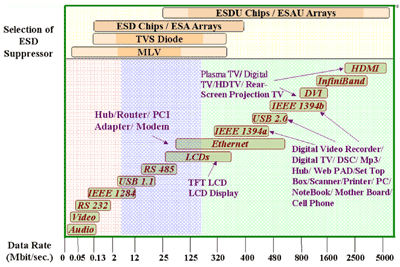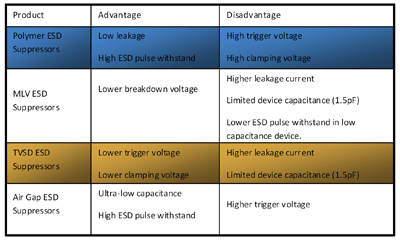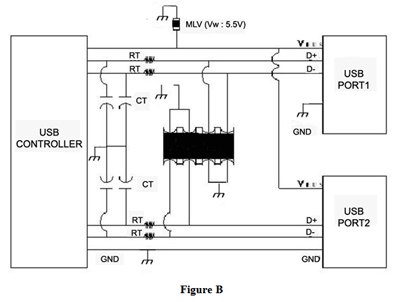Evaluating high-speed ESD suppression technologies
ESD suppression evolves to meet the needs of today’s high-speed data
BY KORY SCHROEDER
Stackpole Electronics, Raleigh, NC
http://www.seielect.com
The recent acceleration of data rates fueled by the high-definition television and monitor markets, as well as by the faster USB 2.0 and 3.0 protocols, have made some of the more traditional ESD protection techniques obsolete. The high capacitance, leakage current, and clamping voltage of silicon diodes and multilayer varistors do not allow them to accurately and reliably protect the interfaces associated with high-data-rate signals without significant signal degradation.
Improvements to gap technology, specifically using air as the gap, has led to dramatic improvements in low-capacitance suppressors, lower leakage current, and lower clamping voltage. Finally, polymer gap suppressors can degrade under repetitive or continuous ESD events, while an air gap device will maintain very low capacitance, low leakage current, and low trigger voltage even after 1,000 ESD events at 1-s intervals.

ESD suppression solutions in terms of data rate
ESD protection solutions overview
TVS diodes and multilayer varistors are excellent choices for protecting any connection with data rates of around 350 Mbits/s or less. These applications include standard definition LCD displays, TFT displays, and many of the usual computer peripheral ports and connections. Those signals inherently allow for higher insertion loss and higher clamping and trigger voltages. TVS diode and multilayer varistor technologies are also effective in protecting the power pins of the other high-speed interfaces, such as USB 2.0 and higher. Since these power pins don’t have any signals applied to them, high-speed suppression response isn’t necessary. However, for the data communication lines for interfaces such as DVI, HDMI, USB, and the latest IEEE 1394 A and B standards, high-speed response with minimal signal distortion is critical for proper system performance and circuit protection. These types of connections are present in digital video equipment, MP3 players, cell phones and PDAs, network hubs, cable and satellite TV boxes, printers, scanners, copiers, and laptop and netbook computers.

Suppressor technology comparison
The table provides an overview of the strengths and weaknesses of the core technologies used in ESD suppression devices. Polymeric ESD suppression devices work on the breakdown of the inserted polymer between two electrode contacts. They provide the lowest leakage current of any technology and can withstand very-high-voltage ESD pulses, although after repetitive ESD events polymeric devices begin to degrade. In addition, the relatively high trigger and clamping voltages, which are 50 to 100 times higher than air space discharge products, can mean that too much of the ESD pulse energy is allowed through to the protected circuitry.
For years, multilayer varistors have been effectively used for ESD suppression on many types of electrical equipment. Multilayer varistors are well-defined products that work on the concept of voltage breakdown at the boundaries of metal oxide crystals. Their relatively low breakdown voltage and trigger voltages, as well as their ability to withstand many pulses, are certainly desirable. However, multilayer varistors have high leakage current, high capacitance, and detrimental effects of lowering capacitance that make them impossible to use for high-speed applications.
TVSD (silicon)based devices work on the breakdown of a standard p/n junction, which provide relatively lower trigger and clamping voltages compared to polymer-gapbased devices. On the down side, their leakage current is 10 to 20 times higher than an air-gap device and their relatively high inherent capacitance causes higher signal distortion and insertion loss.
Air-gapbased devices provide the lowest possible capacitance and clamping voltage of any technology discussed. This technology works on the breakdown of the inert gas between electrodes. Air-gapbased devices can protect against pulses as high as 15 kV, and their performance characteristic is extremely stable after 1,000 pulses (see Fig. 1 ). Leakage current is slightly higher than that of a polymeric-gapbased device, however the capacitance and the effective insertion loss is equal to or better than the polymer device, with much lower clamping and trigger voltage.

Fig. 1. The performance characteristic of air-gap–based devices is extremely stable after 1,000 pulses.
Applications, end products
Many high-speed applications and end products can be properly protected with a combination of gap-based devices for their data and clock lines, and with multilayer varistors or silicon-based TVS devices for the power connections. USB ports, for example, require high-speed protection for their D+ and D– lines, which can be accomplished with discrete chips and with an additional multilayer varistor or TVS devices for the VDD ’s power via USB line. Many PCs, laptops, and netbooks have multiple USB port connections.
For these devices, the data line pairs for two separate ports can be protected with a single-chip array between the USB controller and the ports themselves (see Fig. 2 ). Ideally, the ESD suppression components should be located as close as physically possible to the USB port to ensure proper circuit protection.

Fig. 2. The data line pairs for two separate ports can be protected with a single-chip array between the USB controller and the ports themselves.
Multiple HDMI connections are now very common on high-definition televisions and monitors. These connectors have 19 total pins, including three data channel pairs each with a ground, a TMDS clock pair plus ground, and DDC data, clock, and CE remote lines, which all require high-speed suppression.
By combining two of the data line pairs into one array and the other data line pair with the TMDS clock pair, two ESD suppression arrays can effectively protect eight high-speed connections. The final three lines can be protected with discrete ESD suppression chips.

An 0201 size is projected to be available in the future although the exact time frame for their availability is still uncertain. For these SIM cards, the discrete high-speed suppression chips are used to protect the I/O, clock, and reset lines, while a multilayer varistor or TVS device protects the VCC power pin.
Faster data communication rates associated USB, HDMI, DVI, and other high-speed protocols have rendered past ESD solutions obsolete. The multilayer varistors and TVS on silicon devices have far too much capacitance to allow the high-speed communication without distortion or insertion loss. New gap-based devices have lowered the effective capacitance of relevant suppression devices down to the 0.05-pF range and below. In addition, gap-based devices offer very low leakage current and reliable response even to a thousand ESD events. Recent breakthroughs allow for the creation of air-gap–based ESD suppressors with the lowest possible capacitance as well as low trigger and clamping voltage compared to polymeric-gap technology. Lower trigger and clamping voltages means more accurate protection and less energy from the ESD event reaching the sensitive communications platforms leading to improved long-term reliability. ■
Advertisement
Learn more about Stackpole Electronics





